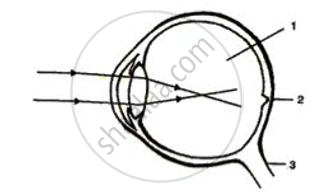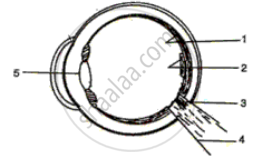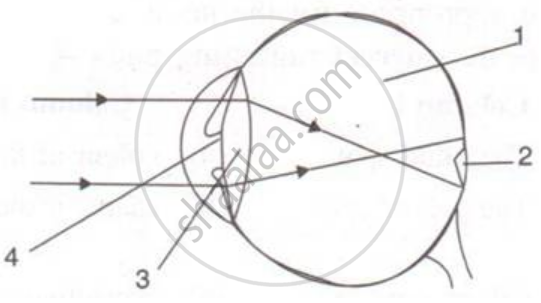Advertisements
Advertisements
प्रश्न
Complete the following table by observing the given figures:
| Figure → |  |
 |
| Points ↓ | ||
| (a) Name of the defect | ______ | ______ |
| (b) Position of the image | ______ | ______ |
| (c) Lens used to correct the defect | ______ | ______ |
उत्तर
| Figure → |  |
 |
| Points ↓ | ||
| (a) Name of the defect | Myopia (near sightedness) |
Hypermetropia (Far sightedness) |
| (b) Position of the image | In front of the retina | Behind the retina |
| (c) Lens used to correct the defect | Concave lens | Convex lens |
APPEARS IN
संबंधित प्रश्न
Millions of people in the developing countries of the world are suffering from corneal blindness. These persons can be cured by replacing the defective cornea with the cornea of a donated eye. A charitable society of your city has organised a campaign in your neighbourhood in order to create awareness about this fact. If you are asked to participate in this mission, how would you contribute in this noble cause?
(i) State the objective of organising such campaigns.
(ii) List two arguments which you would give to motivate the people to donate their eyes after death.
(iii) List two values which are developed in the persons who actively participate and contribute in such programmes.
List three common refractive defects of vision. Suggest the way of correcting these defects.
A person with a myopic eye cannot see objects beyond 1.2 m distinctly. What should be the type of the corrective lens used to restore proper vision?
Which defect of vision can be rectified:
by using a concave lens?
Name the defect of vision which makes the eye-lens cloudy resulting in blurred vision.
Name the body part with which the terms myopia and hypermetropia are connected.
Your friend can read a book perfectly well but cannot read the writing on blackboard unless she sits on the front row in class.
What type of lenses-converging or diverging-would an optician prescribe for her?
A man can read the number of a distant but clearly but he finds difficulty in reading a book.
From which defect of the eye is he suffering?
A student sitting in the last row of the class-room is not able to read clearly the writing on the blackboard.
How can this defect by corrected?
Explain with the help of labelled ray diagram, the defect of vision called myopia and how it is corrected by a lens.
What is short-sightedness? State the two causes of short-sightedness (or myopia). With the help of ray diagrams, show:
(i) the eye-defect short-sightedness.
(ii) correction of short-sightedness by using a lens.
A person having short-sight cannot see objects clearly beyond a distance of 1.5 m. What would be the nature and power of the corrective lens to restore proper vision?
What is long-sightedness? State the two causes of long-sightedness (or hypermetropia). With the help of ray diagrams, show:
(i) the eye-defect long-sightedness.
(ii) correction of long-sightedness by using a lens.
An eye has a far point of 2 m. What type of lens in spectacles would be needed to increase the far point to infinity? Also calculate the power of lens required. Is this eye long-sighted or short-sighted?
Though a woman can see the distant object clearly, she cannot see the nearby objects clearly. She is suffering from the defect of vision called:
(a) long-sight
(b) short-sight
(c) hind-sight
(d) mid-sight
Differentiate between members of the following pair with reference to what is asked in the bracket.
Rods and cones (sensitivity).
Describe the mechanism of focusing the image of a distant object in your eye when you raise your head after reading a book.
Enumerate the common defects of vision, their causes and the possible methods of correcting them.
Have a look at the posture of this girl who is reading a book and answer the questions which follow:

Name the problem she is facing.
What eye defect is hypermetropia? Describe with a ray diagram how this defect of vision can be corrected by using an appropriate lens.
Draw a ray diagram to show how Hypermetropia is defect can be corrected using a lens.
State the main functions of the following:
Tears
List two causes of presbyopia. Draw labelled diagram of a lens used for the correction of this defect of vision.
Write whether the following is true or false:
A convex lens is used for correcting myopia.
Given alongside is a diagram depicting a defect of the human eye. Study the same and then answer the questions that follow:
(i) Identify the defect.
(ii) Name the parts labelled 1, 2 and 3.
(iii) Give labelled two possible reasons for this eye defect.
(iv) Draw a labelled diagram to show how the above mentioned defect is rectified.

The diagram alongside represents a section of a mammalian eye.
(i) Label the parts 1 to 5 of the diagram.
(ii) State the function of the parts labelled 4 and 5.
(iii) With the help of a diagram show the short sightedness.

Given below is a diagram depicting a defect of the human eye? Study the same and answer the question that follow:

Give two possible reasons for this defect of the eye in human beings.
Have a look at the posture of this woman who is reading a book and answer the questions which follow:

What kind of looking glasses she needs?
Choose the Odd One Out:
What are the causes of ‘Myopia’?
Myopia and hypermetropia can be corrected by:
Assertion: Myopia is the defect of vision in which a person cannot see distant objects clearly.
Reason: This due to eye-ball being too short.
State reasons for Myopia. With the help of ray diagrams, show the:
- image formation by a myopic eye, and
- correction of myopia using an appropriate lens.
